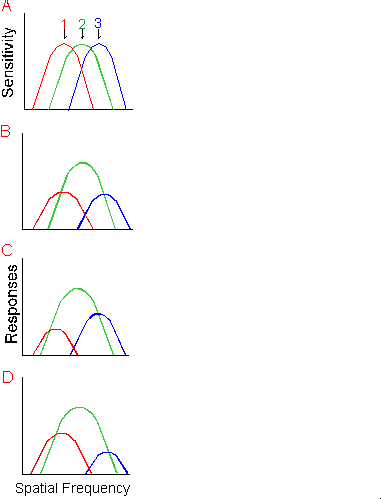 Hypothetical tuning curves for three spatial frequency channels.
Hypothetical tuning curves for three spatial frequency channels.A.1. peak sensitivity of upper left grating
... 2. peak sensitivity of two right gratings
... 3. peak sensitivity of lower left grating
B.Responses
of three channels when observer looks at the gratings on the
right before adapting. Because curve 2 is more sensitive to this spatial frequency its
response is higher than the other two channels.
C.Response
of the three channels when the observer looks at the gratings on
the right after adapting to the lower frequency grating in the upper left. Because the
lower frequency channel is less sensitive than it was above, the upper right grating will appear to have a slightly higher spatial frequency.
D.Response
of the three channels when the observer looks at the gratings on
the right after adapting to the higher frequency grating in the lower left. Because the
higher frequency channel is less sensitive that it was above, the lower right grating will appear to have a slightly higher spatial frequency.
For a more detailed explanation select more information
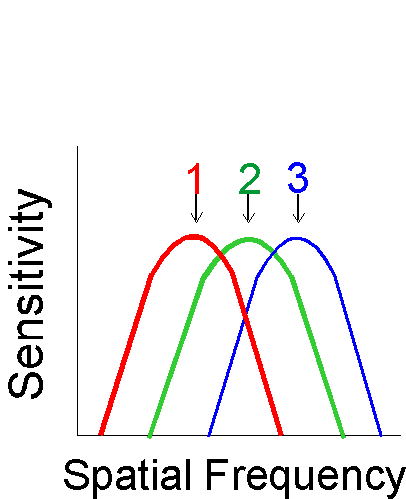
Hypothetical tuning curves for three spatial frequency channels.
1.
peak sensitivity of upper left grating
2.
peak sensitivity of two right gratings
3.
peak sensitivity of lower left grating
A visual scientist at the University of Chicago, Dr. Hugh Wilson, has determined that many
spatial visual phenomena can be explained by hypothesizing 6 spatial frequency channels.
Here, for illustrative purposes, I use only 3. Each curve represents the sensitivity as a
function of spatial frequency, in cycles per degree, of a visual neural mechanism that is
responsible for processing spatial information. Our perception of objects depends on the
total response of all the channels. In the grating demonstration I identified curve 2, on the
right, as the one whose peak sensitivity is the same as the spatial frequency of the two gratings that were on the right side. In point of fact, all of
three the curves (tuning curves) will respond to these gratings, but to differing degrees.
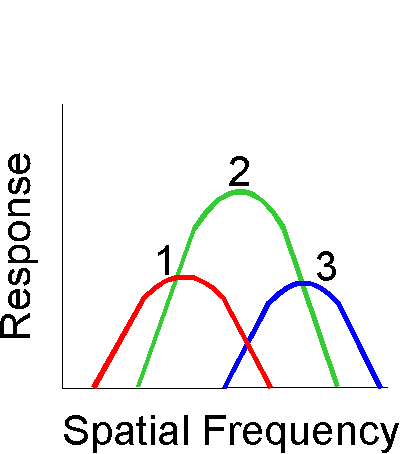
Responses of three channels when the observer looks at the gratings on the right before adapting.
Because curve 2 is more sensitive to this spatial frequency its response is higher than the other two channels.
The three spatial frequency channels of the visual system we hypothesized would respond to the two gratings on the right side (which as you will recall were identical) according to the response curves shown here on the right.
Recall that we said the peak of curve 2 was at the same spatial frequency of the gratings we saw on the right. However, you can see that curves 1 and 2 also have a small response to this spatial frequency. Therefore, our perception of these gratings would be effected by the responses of all three channels.
Let us now see what happens when we adapt to a lower spatial frequency (the top left grating) and a higher spatial frequency (lower left grating) than the gratings on the right.
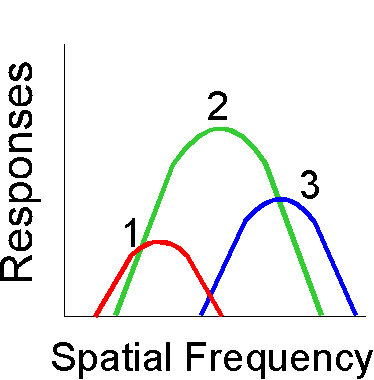
Response of the three channels when the observer looks at the gratings on the right after adapting to the lower frequency grating in the upper left.
Because the lower frequency channel is less sensitive than it was in the previous example, the upper right grating will appear to have a slightly higher spatial frequency than the lower right grating.
Now that you will have moved your eye back and forth along the red bar on the left side of the grating figure you will have adapted to the lower spatial frequency at the top and to the higher spatial frequency grating as the bottom. The figure on the right represents the reponse of the visual system to the top right grating after adapting to the upper left grating. The strongest response is still curve 2 because the peak frequency of this curve is the same as the spatial frequency of the gratings on the right. Curve 1 is reduced because of the adaptation caused by the upper left grating. You can see that prior to adaptation there is a relatively stronger lower frequency response. Therefore the top right grating will appear to have a higher spatial frequency after adaptation than it did prior to adaptation.
In the next figure we can see what happens as a result of adapting to the higher spatial frequency grating in the lower left.
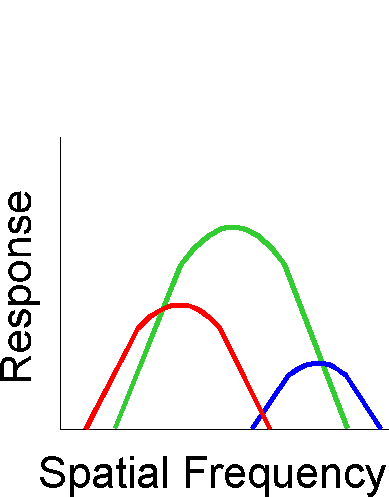
Response of the three channels when the observer looks at the gratings on the right after adapting to the higher frequency grating in the lower left.
Because the higher frequency channel is less sensitive than it was in the previous example, the lower right grating will appear to have a slightly lower spatial frequency.
The curves on the right represent the responses to looking at the lower right grating.
Recall that the lower left grating had the highest spatial frequency. After adapting to it, curve 3 on the right is reduced. Remember that the spatial frequency we observe is dependent on the responses of all the spatial frequency channels.
From the curves on the right you can see that there will be a bias toward the lower spatial frequency, therefore the bottom right grating will appear to have a lower spatial frequency than it did prior to adaptation and its apparent spatial frequency will be less than that of the grating just above it which physically has the same spatial frequency.
Mathieu Le Corre (Ph.D. student, NYU, December 2000), kindly suggested it is important to note that if the two physically identical gratings on the right appear different after adaptation, it is because the adapted channels in the upper retinal field are not the same as the adapted channels in the lower retinal field. [I thank Mathieu for identifying two critical errors in this section.]